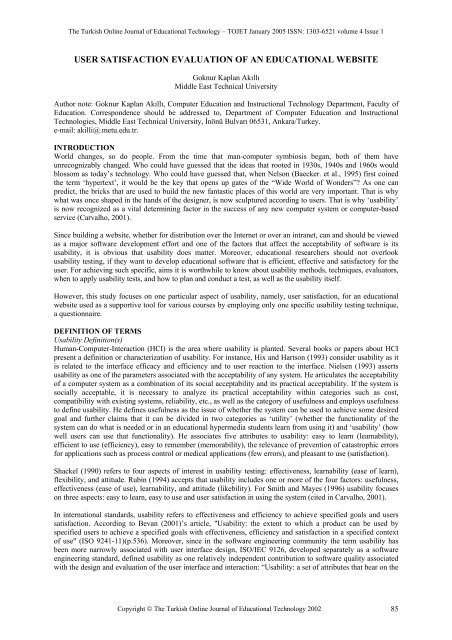Age - TOJET the Turkish online journal of educational technology
Age - TOJET the Turkish online journal of educational technology
Age - TOJET the Turkish online journal of educational technology
You also want an ePaper? Increase the reach of your titles
YUMPU automatically turns print PDFs into web optimized ePapers that Google loves.
The <strong>Turkish</strong> Online Journal <strong>of</strong> Educational Technology – <strong>TOJET</strong> January 2005 ISSN: 1303-6521 volume 4 Issue 1<br />
USER SATISFACTION EVALUATION OF AN EDUCATIONAL WEBSITE<br />
Goknur Kaplan Akıllı<br />
Middle East Technical University<br />
Author note: Goknur Kaplan Akıllı, Computer Education and Instructional Technology Department, Faculty <strong>of</strong><br />
Education. Correspondence should be addressed to, Department <strong>of</strong> Computer Education and Instructional<br />
Technologies, Middle East Technical University, İnönü Bulvarı 06531, Ankara/Turkey.<br />
e-mail: akilli@.metu.edu.tr.<br />
INTRODUCTION<br />
World changes, so do people. From <strong>the</strong> time that man-computer symbiosis began, both <strong>of</strong> <strong>the</strong>m have<br />
unrecognizably changed. Who could have guessed that <strong>the</strong> ideas that rooted in 1930s, 1940s and 1960s would<br />
blossom as today’s <strong>technology</strong>. Who could have guessed that, when Nelson (Baecker. et al., 1995) first coined<br />
<strong>the</strong> term ‘hypertext’, it would be <strong>the</strong> key that opens up gates <strong>of</strong> <strong>the</strong> “Wide World <strong>of</strong> Wonders”? As one can<br />
predict, <strong>the</strong> bricks that are used to build <strong>the</strong> new fantastic places <strong>of</strong> this world are very important. That is why<br />
what was once shaped in <strong>the</strong> hands <strong>of</strong> <strong>the</strong> designer, is now sculptured according to users. That is why ‘usability’<br />
is now recognized as a vital determining factor in <strong>the</strong> success <strong>of</strong> any new computer system or computer-based<br />
service (Carvalho, 2001).<br />
Since building a website, whe<strong>the</strong>r for distribution over <strong>the</strong> Internet or over an intranet, can and should be viewed<br />
as a major s<strong>of</strong>tware development effort and one <strong>of</strong> <strong>the</strong> factors that affect <strong>the</strong> acceptability <strong>of</strong> s<strong>of</strong>tware is its<br />
usability, it is obvious that usability does matter. Moreover, <strong>educational</strong> researchers should not overlook<br />
usability testing, if <strong>the</strong>y want to develop <strong>educational</strong> s<strong>of</strong>tware that is efficient, effective and satisfactory for <strong>the</strong><br />
user. For achieving such specific, aims it is worthwhile to know about usability methods, techniques, evaluators,<br />
when to apply usability tests, and how to plan and conduct a test, as well as <strong>the</strong> usability itself.<br />
However, this study focuses on one particular aspect <strong>of</strong> usability, namely, user satisfaction, for an <strong>educational</strong><br />
website used as a supportive tool for various courses by employing only one specific usability testing technique,<br />
a questionnaire.<br />
DEFINITION OF TERMS<br />
Usability Definition(s)<br />
Human-Computer-Interaction (HCI) is <strong>the</strong> area where usability is planted. Several books or papers about HCI<br />
present a definition or characterization <strong>of</strong> usability. For instance, Hix and Hartson (1993) consider usability as it<br />
is related to <strong>the</strong> interface efficacy and efficiency and to user reaction to <strong>the</strong> interface. Nielsen (1993) asserts<br />
usability as one <strong>of</strong> <strong>the</strong> parameters associated with <strong>the</strong> acceptability <strong>of</strong> any system. He articulates <strong>the</strong> acceptability<br />
<strong>of</strong> a computer system as a combination <strong>of</strong> its social acceptability and its practical acceptability. If <strong>the</strong> system is<br />
socially acceptable, it is necessary to analyze its practical acceptability within categories such as cost,<br />
compatibility with existing systems, reliability, etc., as well as <strong>the</strong> category <strong>of</strong> usefulness and employs usefulness<br />
to define usability. He defines usefulness as <strong>the</strong> issue <strong>of</strong> whe<strong>the</strong>r <strong>the</strong> system can be used to achieve some desired<br />
goal and fur<strong>the</strong>r claims that it can be divided in two categories as ‘utility’ (whe<strong>the</strong>r <strong>the</strong> functionality <strong>of</strong> <strong>the</strong><br />
system can do what is needed or in an <strong>educational</strong> hypermedia students learn from using it) and ‘usability’ (how<br />
well users can use that functionality). He associates five attributes to usability: easy to learn (learnability),<br />
efficient to use (efficiency), easy to remember (memorability), <strong>the</strong> relevance <strong>of</strong> prevention <strong>of</strong> catastrophic errors<br />
for applications such as process control or medical applications (few errors), and pleasant to use (satisfaction).<br />
Shackel (1990) refers to four aspects <strong>of</strong> interest in usability testing: effectiveness, learnability (ease <strong>of</strong> learn),<br />
flexibility, and attitude. Rubin (1994) accepts that usability includes one or more <strong>of</strong> <strong>the</strong> four factors: usefulness,<br />
effectiveness (ease <strong>of</strong> use), learnability, and attitude (likebility). For Smith and Mayes (1996) usability focuses<br />
on three aspects: easy to learn, easy to use and user satisfaction in using <strong>the</strong> system (cited in Carvalho, 2001).<br />
In international standards, usability refers to effectiveness and efficiency to achieve specified goals and users<br />
satisfaction. According to Bevan (2001)’s article, "Usability: <strong>the</strong> extent to which a product can be used by<br />
specified users to achieve a specified goals with effectiveness, efficiency and satisfaction in a specified context<br />
<strong>of</strong> use" (ISO 9241-11)(p.536). Moreover, since in <strong>the</strong> s<strong>of</strong>tware engineering community <strong>the</strong> term usability has<br />
been more narrowly associated with user interface design, ISO/IEC 9126, developed separately as a s<strong>of</strong>tware<br />
engineering standard, defined usability as one relatively independent contribution to s<strong>of</strong>tware quality associated<br />
with <strong>the</strong> design and evaluation <strong>of</strong> <strong>the</strong> user interface and interaction: “Usability: a set <strong>of</strong> attributes that bear on <strong>the</strong><br />
Copyright © The <strong>Turkish</strong> Online Journal <strong>of</strong> Educational Technology 2002 85
















